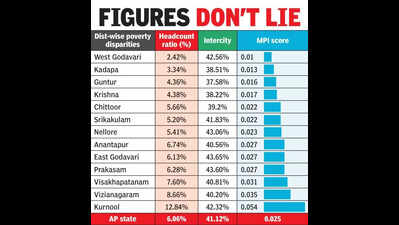Vijayawada: The state govt asserted that it is committed to eradicate poverty and achieve zero poverty by 2030, aligning with the United Nations Sustainable Development Goals (SDGs) and India’s ‘Viksit Bharat 2047′ vision. The govt claimed it has successfully reduced poverty through welfare programs, employment generation, skill development, and social inclusion initiatives.
The socio-economic survey for 2024-25, however, has suggested that to sustain and accelerate poverty reduction, the3 state must integrate welfare programs with economic growth strategies to ensure long-term financial independence for all citizens. “Increase financial inclusion and direct assistance to vulnerable groups. Improve healthcare, education and housing infrastructure. Expand MSME sector and vocational training programs. Link DBT beneficiaries to job opportunities and self-employment schemes. Integrate AI and digital economy jobs into employment strategies. Ensure skill-based employment to eliminate dependence on welfare,” the report advocated.
AP ranks ninth, below Telangana, in multidimensional poverty index (MPI) in the country. While Kerala has the lowest poverty rate with just 0.002 percent MPI score, Goa, Tamil Nadu, Sikkim, Punjab, HP, and Mizoram took the second to seventh spots above Telangana and AP. Interestingly, just around 6.06 percent of AP’s population is under poverty, while the national average is 14.96 percent.
According to the socio-economic survey, AP, one of India’s fastest-growing states, has witnessed a significant decline in poverty levels over the past two decades. The state has implemented targeted welfare programs, rural employment schemes, and financial inclusion initiatives to improve the living conditions of its people. However, challenges persist, including regional disparities. Certain districts, especially those with a high tribal population, continue to experience poverty. Although urban poverty has reduced significantly, rural poverty remains a concern due to agriculture dependency, seasonal unemployment, and climate vulnerabilities.
On the positive side, AP has outperformed many Indian states in poverty alleviation. According to the 2023 NITI Aayog multidimensional poverty index report, the state’s MPI score decreased to 0.025 (2019-21) from 0.053 (2015-16), showing a 50% reduction in poverty levels. The state is emerging as a hub for innovative poverty alleviation programs, particularly in women’s empowerment, rural employment, housing, and digital inclusion. However, to achieve zero poverty, it is essential to bridge the gaps in rural development, employment generation, and financial inclusion.
Although AP performed decently well in some of the indicators such as housing, cooking fuel, maternal health, school attendance, electricity and assets, there are certain concerns in respect of some of the indicators like years of schooling, drinking water, sanitation, bank accounts, child-adolescent mortality and nutrition, which may require special attention.
The survey found that West Godavari, with an MPI value of 0.010, tops the list of districts with lowest poverty, while Kurnool (MPI of 0.054) stands at the bottom with high poverty. Among other districts, Anantapur, East Godavari, Visakhapatnam, Prakasam, Vizianagaram and Kurnool have higher poverty (MPI) and higher head count ratio.
AP has pioneered several innovative programs to combat poverty, ensuring direct benefit transfers (DBT), rural employment, and empowerment initiatives reach marginalized communities. The report said DBT welfare programmes ensure timely financial assistance to low-income households and also reduces leakages and middlemen interference in welfare schemes. “DBT increases access to education, healthcare, and social security. It empowers women through SHGs and microfinance programs,” said the report. As poverty reduction is directly linked to sustainable livelihood generation, the state govt has launched several programs to promote self-employment, entrepreneurship, and financial inclusion.








